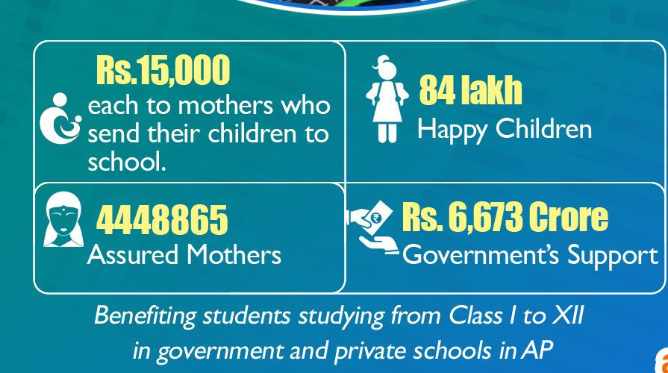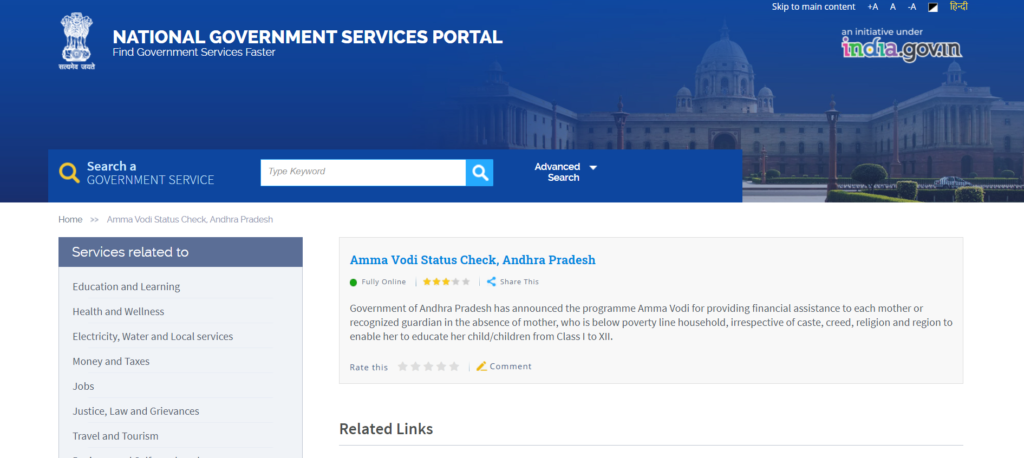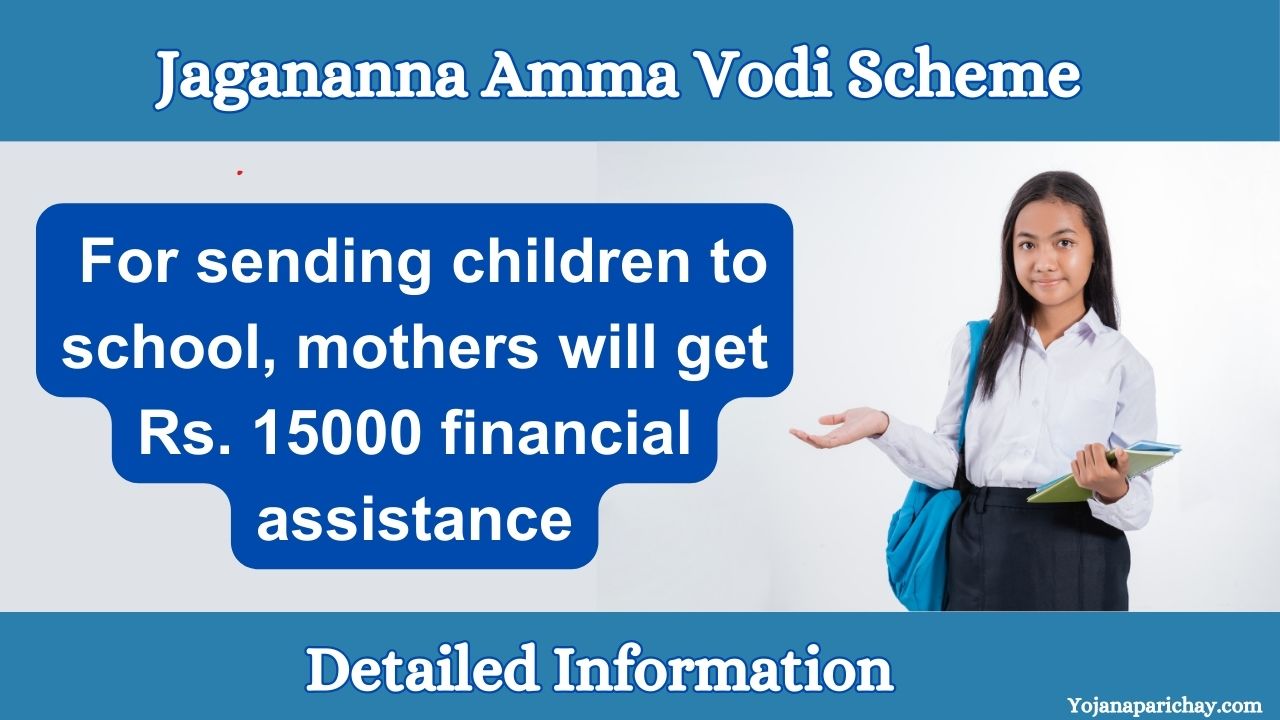The Jagananna Amma Vodi Scheme, a flagship initiative of the Andhra Pradesh government, has emerged as a transformative force in the state’s education landscape. Launched with the aim of enhancing school enrollment, improving attendance, and ensuring quality education, the scheme has made significant strides in improving the lives of countless children and their families.
What is Jagananna Amma Vodi Scheme ?
Jagananna Amma Vodi Scheme is a conditional cash transfer program that provides financial assistance to mothers (or recognized guardians) of children studying in government, aided, and private schools from Classes I to XII. The scheme aims to support families in meeting the educational expenses of their children, thereby reducing dropout rates and improving overall educational outcomes.
The Jagananna Amma Vodi Scheme’s goals
The following are the main goals of the Jagananna Amma Vodi Scheme:
- Increasing school enrollment: To get more kids into the classroom, especially those from lower-income families.
- Lowering dropout rates: To stop kids from leaving school early because of financial difficulties.
- Enhancing school attendance: To encourage consistent attendance by offering moms cash incentives.
- Giving women a significant part in their children’s education is one way to empower them.
- Reducing financial burden: To make it easier for families to afford the education of their children.
- Enhancing educational results: To make sure that kids continue their education in order to help them learn more.
- Encouraging gender equality means making sure that boys and girls have equal access to education.

Key Features of the Jagananna Amma Vodi Scheme
- Financial Assistance: Eligible mothers receive an annual financial assistance of ₹15,000 per child, which is directly transferred to their bank accounts.
- Eligibility: The scheme covers children studying in government, aided, and private schools from Classes I to XII.
- Conditional Cash Transfer: The financial assistance is linked to the child’s attendance in school, with certain attendance criteria to be met.
- Direct Benefit Transfer: The funds are transferred directly to the mother’s bank account, ensuring transparency and accountability.
- Targeting: The scheme prioritizes children from economically weaker sections of society.
Benefits of the Jagananna Amma Vodi Scheme
- The Jagananna Amma Vodi Scheme offers several benefits to families and children in Andhra Pradesh:
- Financial Support: Provides direct financial assistance to mothers to meet educational expenses for their children.
- Increased School Enrollment: Encourages families to send their children to school by providing financial incentives.
- Improved School Attendance: Regular financial support motivates families to ensure consistent school attendance.
- Reduced Dropout Rates: Helps to keep children in school by alleviating financial burdens.
- Empowerment of Women: Gives mothers a greater role in their children’s education and financial decision-making.
- Improved Educational Outcomes: Contributes to better learning outcomes by ensuring children have access to necessary resources.
- Social Inclusion: Promotes equal educational opportunities for children from all socioeconomic backgrounds.

Jagananna Amma Vodi Scheme Eligibility criteria
- The mother or guardian has to be an Andhra Pradesh resident.
- The mother’s kid or children should be enrolled in first through twelfth grades.
- The youngster should be accepted to or enrolled in a recognized government, private, assisted, or unaided school or college.
- Andhra Pradesh is home to colleges, residential schools, and junior colleges.
- The initiative will begin to take effect in the 2019–20 school year.
- If the family lives in a rural area, their monthly income should not exceed ₹10,000; if they live in an urban area, their monthly income should not exceed ₹12,000 (BPL).
- There shouldn’t be any pensioners or government workers in the child’s family. (With the exception of the families of sanitation workers).
- The applicant’s family should not own a four-wheeler (except from automobiles, tractors, and taxis).
- The applicant’s family housing unit, whether owned or rented, must have a monthly electricity usage of less than 300 units (averaged over six months).
- The applicant’s household should not have any income tax payers.
- Less than 1000 square feet should make up the property under the municipal area.
- At least 75% of the child’s attendance is required.

Required Documents
- Resident Proof of Andhra Pradesh.
- Student ID Card.
- Aadhar Number of Mother or Guardian.
- Aadhar Card of Child.
- Income Certificate.
- Caste Certificate.
- Ration Card/ BPL Certificate.
- Bank Account Details.
Application Process Of Jagananna Amma Vodi Scheme
- Step 1: The only source of information for student enrollment will be the information provided by the Inter College Principal or School Headmaster on the provided proforma, which includes the student’s name, age, parent name, caste (General, SC, ST, BCs, Minority), disabled children, etc.
- Step 2: The information will be cross-validated with data from Civil Supplies and other departments, as well as with Childinfo/UDISE and other data, utilizing the 6-Step Check. The immediate inspecting officer of the institution should certify these facts for payment.
- Step 3: The village/ward secretariat for the social audit will display the Provisional List of Eligible Candidates. The Social Audit will be used to create a list of ineligible candidates, along with the reason(s) why they are not eligible. The notification of the rejection should be sent to the candidate.
- Step 4: The Welfare Education Assistant / Ward Education & Data Processing Secretary is responsible for compiling the final list of qualified candidates. The list will then need to be approved by the District Collector. The Data Processing Secretary, Welfare Education Assistant, and Volunteers will use biometrics to complete the Mother’s e-KYC.
- Step 5: Financial aid shall then be released to the recipients’ online savings bank accounts by the respective District Educational Officers, District Vocational Educational Officers, Regional Educational Officers, and Intermediate Education.
- Step 6: The mothers’ registry will confirm to the volunteers, welfare education assistant, ward education, and data processing secretary that the money has been received through biometric authentication.

Conclusion
The Jagananna Amma Vodi Scheme stands as a testament to the Andhra Pradesh government’s commitment to improving the lives of children through education. By providing direct financial support to mothers, the scheme has empowered families, increased school enrollment, and improved learning outcomes. As the scheme continues to evolve, it has the potential to become a model for other states in addressing educational challenges and ensuring a brighter future for the next generation.
Friends, how did you like the information given about Jagananna Amma Vodi Scheme? You can tell us by commenting. If you have any suggestion regarding the Jagananna Amma Vodi Scheme article, then you can tell us by commenting. Friends, keep visiting our website https://yojanaparichay.com/ to get updated information related to such government schemes.
Frequently Asked Questions (FAQ) :
For whom is the JJagananna Amma Vodi Scheme applicable?
Mothers/guardians of children studying in Classes I to XII in government, aided, or private schools in Andhra Pradesh, belonging to BPL families with a white ration card, are eligible.
What is the amount of financial assistance provided?
Eligible mothers receive an annual financial assistance of ₹15,000 per child.
How is the money disbursed?
The money is directly transferred to the mother’s bank account.
Can the money be used for any purpose?
The money is intended to be used for the child’s education-related expenses, but there are no specific restrictions on its usage.
What occurs if the young person quits school?
The financial assistance might be discontinued if the child drops out of school.
Can I transfer the financial assistance to another bank account?
You may need to contact the relevant authorities to change the bank account details.

